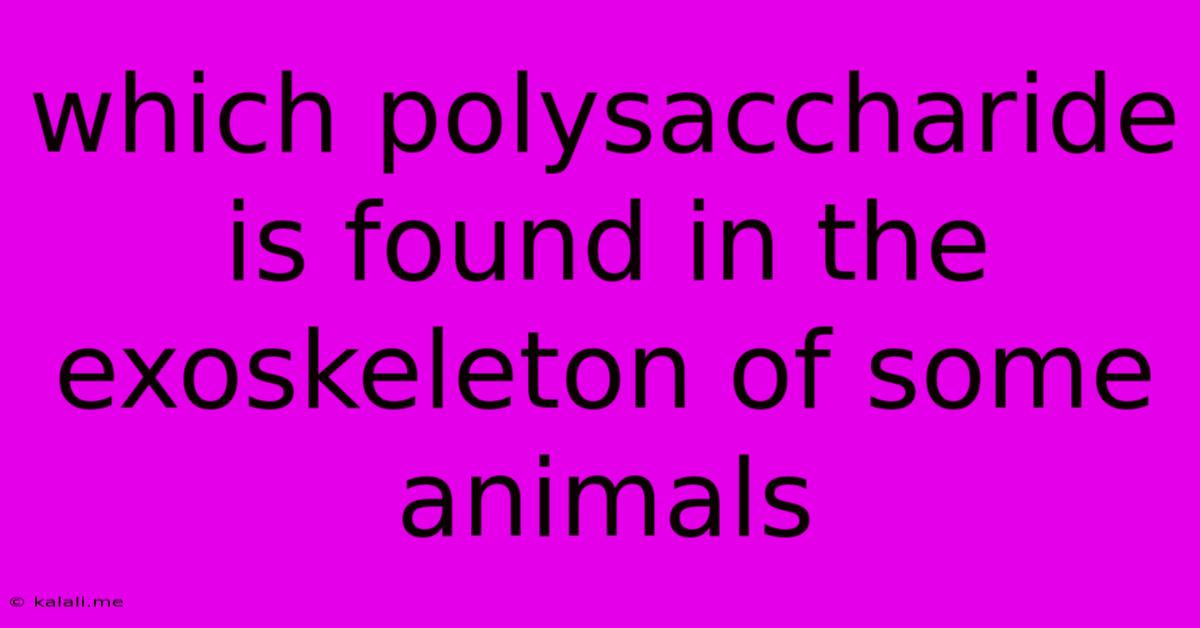Which Polysaccharide Is Found In The Exoskeleton Of Some Animals
Kalali
Jun 13, 2025 · 3 min read

Table of Contents
Chitin: The Tough Polysaccharide Forming the Exoskeletons of Arthropods and More
Meta description: Discover chitin, the crucial polysaccharide forming the tough exoskeletons of insects, crustaceans, and other arthropods. Learn about its structure, function, and broader applications.
The natural world is full of remarkable adaptations, and among the most impressive are the robust exoskeletons found in a vast array of animals. These protective shells aren't made of bone or shell, but of a complex polysaccharide: chitin. This article delves into the fascinating world of chitin, exploring its structure, function, and significance in the animal kingdom.
What is Chitin?
Chitin is a long-chain polymer composed of N-acetylglucosamine (GlcNAc) units, linked together by β-(1→4) glycosidic bonds. This structure is similar to cellulose, another important polysaccharide, but with a key difference: the addition of an acetyl amino group to each glucose unit. This seemingly small modification drastically alters its properties, making chitin much stronger and more resistant to degradation than cellulose.
This structural difference gives chitin its unique properties, making it ideal for its role in exoskeletons. It's lightweight yet incredibly strong, providing excellent protection against predators and environmental stresses. Furthermore, its semi-permeable nature allows for a degree of flexibility and movement.
Chitin's Role in Exoskeletons
Chitin is the primary structural component of the exoskeletons of arthropods, a massive phylum encompassing insects, crustaceans, myriapods (centipedes and millipedes), and arachnids (spiders, scorpions, etc.). These exoskeletons are not just for protection; they also provide:
- Support and Shape: The rigid chitinous structure provides the framework for the animal's body, giving it shape and support.
- Muscle Attachment: Muscles attach to the exoskeleton, allowing for movement.
- Protection from Dehydration: The exoskeleton acts as a barrier, preventing water loss in terrestrial arthropods.
- Protection from Predators: The hard exoskeleton serves as a significant defense against predation.
Beyond Exoskeletons: Other Functions of Chitin
While its role in exoskeletons is most well-known, chitin also plays significant roles in other organisms and has various applications:
- Fungal Cell Walls: Chitin is a major component of the cell walls of fungi, contributing to their structural integrity.
- Insect Tracheae: Chitin is present in the insect respiratory system, providing structural support to the tracheal tubes.
- Biomedical Applications: Due to its biocompatibility and biodegradability, chitin and its derivatives (like chitosan) are used in wound healing, drug delivery systems, and tissue engineering.
- Industrial Applications: Chitin is also being explored for use in various industrial applications, such as creating biodegradable plastics and films.
The Composition of Chitinous Exoskeletons
It's important to note that the exoskeleton isn't purely chitin. It's a composite material, often incorporating proteins and calcium carbonate, which further enhance its strength and flexibility. The precise composition varies depending on the species and the specific part of the exoskeleton. This combination of chitin and other materials results in a remarkably robust and adaptable protective layer.
Conclusion
Chitin, the resilient polysaccharide, is a cornerstone of the animal kingdom, providing crucial structural support and protection for countless species. Its importance extends beyond exoskeletons, highlighting its versatile nature and diverse applications in various fields. Understanding the structure and function of chitin opens a window into the intricacies of biological design and provides valuable insights for future technological advancements.
Latest Posts
Latest Posts
-
Which Statement About Coil Springs Is True
Jun 14, 2025
-
Which Of The Following Is An Antibiotic
Jun 14, 2025
-
Which Of The Following Statements Concerning Viruses Is True
Jun 14, 2025
-
How To Find Minors Of Matrix
Jun 14, 2025
-
How To Find Angle Of Intersection Between Two Curves
Jun 14, 2025
Related Post
Thank you for visiting our website which covers about Which Polysaccharide Is Found In The Exoskeleton Of Some Animals . We hope the information provided has been useful to you. Feel free to contact us if you have any questions or need further assistance. See you next time and don't miss to bookmark.